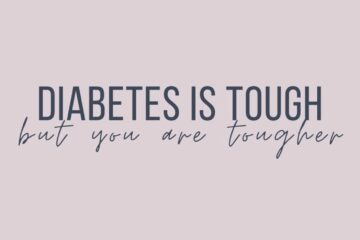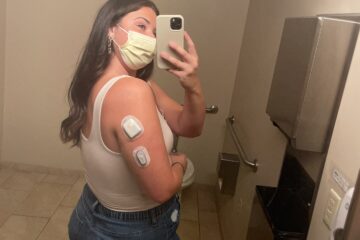Living with Type 1 Diabetes (T1D) is a journey filled with challenges, constant monitoring, and daily adjustments. However, as Grace Cochran—a nurse and T1D advocate—shares, one of the most powerful tools in managing this condition is the support and connection found within the diabetes community. In our conversation, Grace opened up about how social media, in-person communities, and personal experiences have shaped her journey and how she hopes to see education and advocacy for T1D continue to evolve.
The Role of Community in Managing T1D
For many, managing T1D can feel isolating, but Grace emphasizes that having a strong community has been invaluable in navigating the highs and lows of the condition.
“I have a strong community through social media that I talk to and get advice from, and it plays such a massive role in managing Type 1,” she shared. “I can get support when I need support and advice when I need advice, and it has truly been invaluable.”
Social media has become an essential platform for diabetics to connect, share experiences, and offer guidance. While medical professionals play a crucial role in managing diabetes, there’s something uniquely comforting about talking to someone who truly understands what it’s like to live with the condition.
“You can go to your endocrinologist and talk to medical professionals, but they don’t really understand the way a fellow Type 1 diabetic would,” Grace explained. “That’s been the biggest help—having someone who truly understands it and can help you on the same journey.”
Using Social Media to Educate and Advocate
Grace’s online presence has helped raise awareness and educate others about T1D, but she keeps it simple and authentic.
“I usually just do a chat-type thing—I’m not super creative, so I do something easy in terms of posting,” she said. “I’ll talk about things that have been troubling recently in terms of Type 1 or new things that have developed with my management.”
Her conversational approach makes information more digestible and engaging. In recent years, social media has played a significant role in increasing awareness, not only among diabetics but also among those who may know someone with T1D.
“I think people are very open and eager to learn about other diseases,” Grace noted. “When you have young people like us living with Type 1, you wouldn’t look at us and think we have a major disability or health issue—but we do. I think that also is interesting for people to see and provides them with firsthand knowledge that’s not like a commercial or an informational campaign. It’s just real-life examples.”
How Diabetes Influenced Her Career in Nursing
Grace’s personal experience with diabetes also played a role in her decision to enter the medical field.
“When I was first diagnosed and even in college, there were times I had to stay in the hospital. That was always the one place where someone else was managing my diabetes for me,” she recalled. “I felt very safe, but I also could turn that part of my brain off, which is very rare if not unheard of.”
Feeling safe and cared for in a hospital setting inspired her to pursue a career in healthcare so she could provide that same level of comfort to others.
Advocacy and the Need for Better Representation
Despite the progress made in diabetes education, there’s still a lot of misunderstanding, particularly between Type 1 and Type 2 diabetes.
“I’d like people to understand that when they see my devices, their first reaction is often, ‘You don’t look like you have diabetes; you’re too young!’ But that’s just a misunderstanding because their first thought is Type 2,” Grace said.
She also pointed out the need for better representation in diabetes advertisements.
“Anytime I see a commercial for a Dexcom or Freestyle Libre, it’s always an older man,” she noted. “I think it’d be better to have a young, healthy-looking person advertising it because then it’s like, ‘Oh, OK, this is who can have diabetes.’” (Nick Jonas, we miss you!!)
Training for a Marathon with T1D
Grace is currently training for the Chicago Marathon with Breakthrough T1D, something she never imagined would be possible.
“As I got older, things became scarier because I understood the implications,” she admitted. “Two years ago, I never thought it would be possible. But social media helped me realize I didn’t want diabetes to hold me back. If I want to do this, I will find a way to make my blood sugar cooperate.”
She credits technological advancements and support from the diabetes community for making her marathon training a reality.
Rapid-Fire Diabetes Insights
We wrapped up with some fun rapid-fire questions to get a glimpse into Grace’s daily life with diabetes:
- Diabetes quirk: “If my blood sugar is high, I take a hot shower—it helps.”
- Go-to low snack: “Fruit snacks, specifically Welch’s or Mott’s.”
- Food worth extra insulin: “Ice cream—specifically Jeni’s Brambleberry.”
- Favorite site for her devices: “Arms for both my Dexcom and pump.”
- Best diabetes hack: “Drinking water when high—it helps insulin circulate better.”
- Diabetes perk: “In school, I got my own room for exams and could pause the timer to check my blood sugar.”
- First thing she’d do if there was a cure: “Go on a walk without taking anything with me. I just want to be free.”
Final Thoughts: Advice for the Newly Diagnosed
For those recently diagnosed and feeling overwhelmed, Grace’s biggest piece of advice is to seek out a community.
“Actively search for a community that fits you. A lot of major colleges have a group called the College Diabetes Network (CDN). Finding those people and talking to them can be really helpful,” she said.
As for the biggest lesson diabetes has taught her? “Patience.”
Grace’s story is a testament to the power of community, resilience, and advocacy. Whether through social media, in-person groups, or participating in events like marathons, she demonstrates that T1D doesn’t have to be a barrier to living a full, vibrant life.



0 Comments